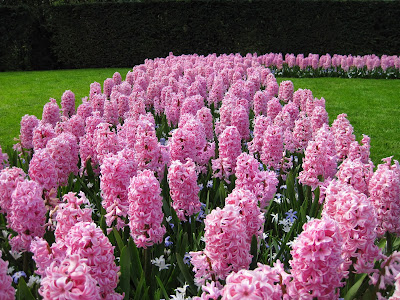As October progresses, we start receiving our plant catalogs for next year and are already coming to some "mental closure" for our gardens. Of course, gardening tasks still abound like late season planting, leaf collection, composting, mulching and certainly the planting of spring blooming bulbs. The season is still perfect for planting bulbs in the fall garden with the exciting implications of dynamic spring color. Garden centers will be selling bulbs well in to November and if you can still get a shovel in the ground, get out there and include bulbs in locations for maximum spring effect. While tulips (Tulipa) and daffodils (Narcissus) seem to reign supreme in gardener's minds for spring bulb interest, the garden hyacinth (Hyacinthus) should be seriously considered for the combination of vivid color and fragrance.
All of the photos in this blog were taken at Keukenhof garden in the Netherlands in April of 2012. I was fortunate to visit this famous garden (founded in 1949) which features over 7 million bulbs (replanted annually) over 80 acres. The garden contains more than bulbs but I caught peak timing for catching the end of daffodils, peak hyacinths and many tulips as well. I can't imagine a better day and spring "bulb window". While these mass plantings and mixed plantings with hyacinths would be costly for the homeowner, they sure show the value of this bulb and smaller scale plantings of hyacinth will not be lacking in impact.
Native to the eastern Mediterranean, this bulb prefers full sun, rich, organic soils and a planting depth around 4-6". This bulb also requires a chilling period in winter and prefers dry summer dormancy (like tulips). At one point in the 18th century, there were over 2,000 cultivars produced (primarily in the Netherlands) when hyacinths were at their most popular. There is only a fraction of those varieties still available but the color range of blue, white, pink, yellow and shades hard to describe should be given consideration. The scent of hyacinths is quite engaging both in the garden and as either a cut flower or "forced" bulb in the home. Hyacinths can be "stand alone" contributors in the spring garden but can also be combined with other bulbs with similar bloom windows. These compositions can be effective or the hyacinths can transition color between the bloom windows of other spring blooming bulbs and the earliest of perennials.
There is a Greek myth that Hyacinthos was a youth that was adored by both Apollo and Zephyrus (god of wind). Zephyrus was jealous of Apollo and did not approve of the competition for the attention of Hyacinthos. Apollo and Hyacinthos were practicing the discus throw and when Hyacinthus lept for a discus thrown by Apollo, the discus (altered in trajectory by Zephyrus) hit him in the head and killed him. From his blood on the soil, the hyacinth flower grew and was named. I found some different versions of this story but that is the short of it. Regardless, as you go to your local garden centers (always support the local vendors first!), look for hyacinths and envision their spring contribution for the eyes and nose! Below are just a small amount of varieties (identified under each photo) and some other fun pictures from Keukenhof.
Hyacinthus 'Blue Festival'
Hyacinthus 'Prince of Love'
Hyacinthus 'Atlantic'
Hyacinthus 'Top Hit'
Hyacinthus 'Blue Jacket' with Hyacinthus 'Carnegie'
Hyacinthus 'Miss Saigon'
Hyacinthus 'Crystal Palace'
Hyacinthus 'Fondant'
Hyacinthus 'Fondant' en masse
hyacinth fields in the Netherlands




























No comments:
Post a Comment